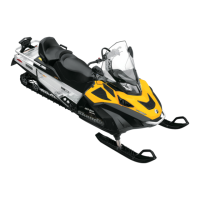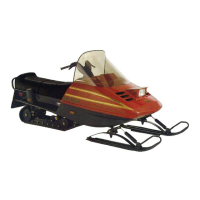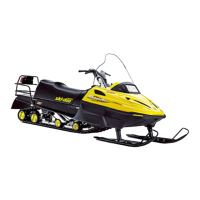RIDING THE VEHICLE
thrown rearward into the path of a fol-
lowing snowmobile. Getting a vehicle
out of a slush area is strenuous and in
some cases, impossible.
Fog or Whiteouts
On land or water, fog or visibil-
ity-limiting snow can form. If you have
to proceed into the fog or heavy snow,
do so slowly with your lights on and
watch intently for hazards. If you are
not sure of your way, do not proceed.
Keep a safe distance behind other
snowmobilers to improve visibility and
reaction time.
Unfamiliar Territory
Whenever you enter an area that is
new to you, drive with extreme cau-
tion. Go slow enough to recognize
potential hazards such as fences or
fence posts, brooks crossing your
path, rocks, sudden dips, guy wires
and countless other obstacles which
could result in a termination of your
snowmobile ride. Even when fol-
lowing existing tracks, be cautious.
Travel at a speed so you can see what
is around the next bend or over the top
of the hill.
Bright Sunshine
Bright sunny days can considerably
reduce your vision. The glare from
sun and snow may blind you to the ex-
tent that you cannot easily distinguish
ravines, ditches or other obstacles.
Goggles with colored lenses should al-
ways be worn under these conditions.
Unseen Obstruction
There may be obstructions hidden
beneath the snow. Driving off es-
tablished trails and in the woods re-
quires reduced speed and increased
vigilance. Driving too fast in an area
can make even minor obstacles ve
ry
hazardous. Even hitting a small rock
or stump could throw your snowmo-
bile out of control and cause i
njury to
its riders. Stay on established trails
to reduce your exposure to hazards.
Be safe, slow down and enjoy the
scenery.
Hidden Wires
Always be on the lookout for hidden
wires, especially in areas that may
have been farmed at one time or an-
other. Too many accidents have been
caused by running into wires in the
fields, guy wires next to poles and
roads, and into chains and wires used
as road closures. Slow speeds are a
must.
Obstacles and Jumping
Unplanned jumps of snowdrifts, snow-
plow ridges, culverts or indistinguish-
able objects can be dangerous. You
can avoid them by wearing the proper
color lenses or face shields and by op-
erating at a lower speed.
Jumping a snowmobile is an unsafe
and dangerous practice. However, if
the trail does suddenly drop away from
you, crouch (stand) towards the rear
ofthevehicleandkeeptheskisup
and straight ahead. Apply partial throt-
tle and brace yourself for the impact.
Knees must be flexed to act as shock
absorbers.
Turning
Depending on terrain conditions, there
are two preferred ways to turn or cor-
ner a snowmobile. For most snow
surfaces, “body english” is the key to
turning. Leaning towards the inside of
the turn and positioning body weight
on the inside foot will create a “bank-
ing” condition beneath the track. By
adopting this position and positioning
yourself as far forward as possible,
weight will be transferred to the in
side
ski.
On occasion, you will find that t
he only
way to turn the vehicle about in deep
snow is topull the snowmobile around.
18
_______
SAFETY I
NFORMATION
________

